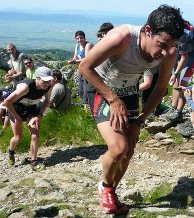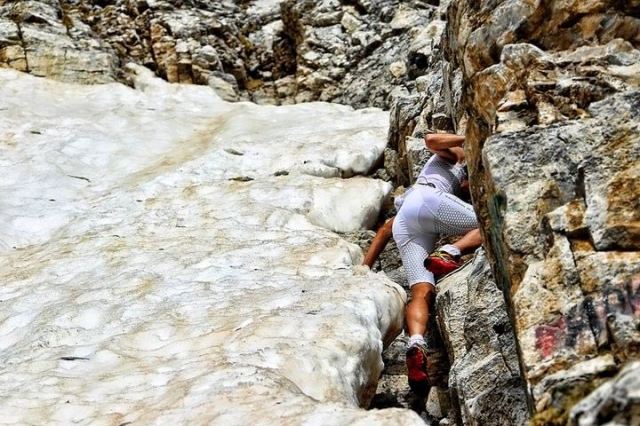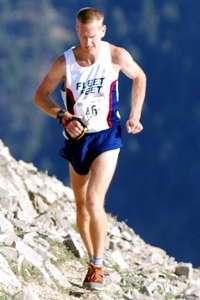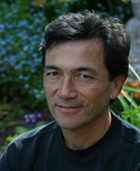This post offers some advice about how to handle the steep uphills on the Ridge Run course. Sure, the Ridge Run is a predominately downhill course loosing a net 2,600 feet in elevation from start to finish, but along the way there are some significant uphill sections. Employing proper technique can save a lot of energy and time.
To Walk or Run that is the Question
As the incline gets steeper, walking becomes a more attractive uphill technique than running. There are some people such as Scott Creel that run the entire course. This includes the steep uphill sections leading up to the summit of Sacajawea and the steep climb out of Ross Pass. While most people walk these steep sections, Scott runs them.
At a certain steepness, 15% grade and steeper, running becomes more work than walking and not much faster. Depending upon your fitness and desire to move fast, you may be lulled into the desire to walk. And it may make sense to transition to walking at even gentler uphill grades than 15%.
Walking as a Welcome Break from Running
I look at steep uphills as a welcome chance to walk. It breaks up the monotony of running. Walking uses different muscles and affords resting those muscles that may be getting tired from running.
A Side Note on Measuring Steepness
You measure steepness or grade in percent. It is the ratio (expressed in percent) of vertical rise to horizontal run. Divide vertical rise by horizontal run and multiply by 100. It is not the same as angle or pitch. For example, a 45 degree slope’s rise is the same as it’s run and thus has a grade of 100%. A 10 degree slope has a grade of 18%. The steepest sustained uphill grades on the Ridge Run course are found climbing out of Ross pass on the way to Bridger. They probably approach 40% (20 degree angle) in places.
For a comparison, very steep highways over mountain passes (think Beartooth Pass) may approach 10% grade (6 degree angle).
Quick Stepping or Gearing Down
Whether you are walking or running, the biggest challenge on uphills is maintaining a quality pace or turnover. Think about taking quick short strides – analogous to gearing down on a bicycle when going uphill. If walking, it is natural to gravitate to one’s normal cadence. This results in an undesirable leisurely saunter. Resisting this urge to go slow requires concentration and conscious effort to remind oneself to keep quick stepping.
Long Stepping
I have seen people effectively employ an exaggerated long but slow stride while walking uphill. Personally I find this requires more energy. But if you have a real strong hips and gluteus muscles this can work. It kind of looks like spy walking or slinking along. This technique is more common with women than men.
Gearing Down works better for me then Long Stepping, but I’ll shift into Long Stepping just for a break and a change. This gives certain muscles a rest.
Hands on Knee Push Offs

Hands on Knee
On real steep terrain, you often see people putting their hands on their thighs above their knees and using their arms to push off. Even Kilian Jornet one of the world’s best trail runners and ski mountaineers uses this technique. I’m not a big fan of it as I find it forces me to slow down my pace or turnover. It works better with Long Stepping than Gearing Down and quick stepping. Using your arms on your thighs is best suited for uphills that are super steep, but not steep enough to use your hands and arms on the terrain itself.
Another advantage of using your hands on your thighs is that it allows your lower back to rest and relax. A common tendency on long sustained uphills is to bend forward at the waist, tiring the lower back. Supporting yourself with your hands mitigates this back fatigue.
I couldn’t resist the next two pictures. They show the extremes of uphill and then of course downhill.

Kilian Jornet Going Up

Kilian Going Down – What Goes Up Must Come Down
Side Stepping to Rest Calves and Achilles
Whether you are running or walking, Side Stepping uphill is a great way to rest the calves and Achilles. Instead of pointing your feet straight up the hill, if you point them to the side and go up sideways. Side Stepping puts less stress on the calf muscle and Achilles. For a break and a rest, you can also alternate between side stepping with the left side facing uphill with the right side facing uphill. I employ the Side Stepping technique frequently.
I have to give credit to Danny Dreyer for showing me this during a trail run. Danny prefers to keep running even on the uphills. Side stepping allows him to gear down and efficiently quick step run the uphills without blowing out his calves.
Fun Background History on Running Theory
Danny Dreyer, who showed me the Side Stepping uphill technique is the founder of Chi Running. My wife was in the same Sex and Running Cult as Danny Dreyer belonged to. This was way back in the 1980’s and 1990’s in Boulder Colorado. It was affectionately known as Divine Madness or The Community. The leader of Divine Madness, Marc Tizer, was able to take people with little or no running background and turn some of them into world class ultra-runners.
During the 1990’s and early 2000’s members of Divine Madness had a string of victories at the Leadville 100 and the National 50 mile, 100K, 24 hour and 48 hour championships. Steve Peterson and Janet Runyan were two the best know runners from Divine Madness.
Both my wife and Danny leveraged what they learned in their years in Divine Madness and wrote books about their experience. My wife wrote a tell-all juicy tale emphasizing the people she got to know there. Danny repackaged the running techniques and theory he learned there as Chi Running. I guess that is the difference between a female and a male perspective on their experience in the Cult. Relationships (female) versus practical stuff (male).
Danny’s rebranding of Mark Tizer’s running theory as Chi Running has been an extremely successful commercial endeavor. On the other hand, commercial success is not a term one would use to describe my wife’s book.
I know Danny has been criticized from the scientific community as not being a scientist and Chi Running not based on science and no different than ideas in the Pose Technique or Cross Fit. So what, there is still lots of value in what Danny accomplished. The Chi Running franchise brought into the mainstream the best ideas about running utilized by Marc Tizer in Divine Madness.
Unfortunately the techniques in Chi Running originated with Marc Tizer – your typical psychopathic cult leader. Danny has not given credit to Tizer. This omission smacks of plagiarism. Not giving credit to where credit is due makes Chi Running foundations being one of deception. Perhaps that is understandable or even justifiable given the controversial nature of the original source – Marc Tizer. But it certainly is not professional and honest.
Running technique and form is a hot topic and Chi Running is right in the middle of the debate. I’ll chime in with more of my ideas about running form in a future post on this blog.



These are pretty old posts. But I was in the community too, for 20 years, and am working on a book also. I was quite steeped in the running techniques, found their benefits and detriments. As well as Yo’s. My book should be ready in about 6 months. I’ll post back when it is.
Hi, I also every now and then search for old Community members. Always a shock to find something I havent before. Dont know who you are or who your wife is but I would sure like to read her book. So much went untold and hidden and there has been so little validation and sharing of experience of getting out and trying to recover from being there. I was in the group from 1984-1990. Its so wierd to see the few people I can find, now that we are all much older, and I wonder how other people have put it behind them sucessfully. Thats not my real name in my email, I still have paranoia about being found by Yo, stupid I know, but something I still have. It was the best and worst 6 years of my life. Id really appreciate anything you are willing to share. Thanks.
Every once in a while I google ‘Marc Tizer’ or ‘Yousamien’ just to see if anything new pops up – mostly it’s stuff from years back. Like one of your respondents, I, too am a former Harmonizer who married another ex -member (Celia would recognize her name, but I won’t put it out in public, even though we’ve been divorced for going on three years after being together for twenty-three).
And if your wife still has one, I’d love to get a copy of her book (FWIW, Lhasha lives here in Tucson too).
I would love to read your wife’s book. Any chance of getting a copy? I was a member of Harmonizing/The Community for 2 years 1979-1981. As I am now a physician, I am hesitant to have it become common knowledge that I was once a member of a group that was basically a cult, so I would appreciate having my name and email kept confidential.
Hi. I just found your blog. I’m afraid that I too, am curious as to the title of your wife’s book. After failing in my first attempt at a 50 mile trail race the previous year, I signed up for the 2004 FANS 12 hour race, just to see if I could run 50 miles in any venue. My friend Kevin, the defending champion, pointed out that Divine Madness was coming to the event. What’s Divine Madness? I guess that it made quite an impression on me to watch Steve Peterson, Joe Gaebler and Kevin lap me repeatedly over the course of the day. So I’ve read what’s available about Yo and his curious runners through the years, but wish that more of the story were available.
Thanks for your comments and interest.
My wife wrote her book about Divine Madness about 15 years ago. It is no longer available in print.
I have found some backup electronic versions from when she wrote it. I am in the process of getting it organized and putting all the doc files on the web.
Only a small fraction (a single chapter out of 40 chapters) of her book is devoted to ultra-running.
Danny Dreyer’s book on Chi Running covers some of the Divine Madness running form details and focuses. Danny couches what he learned in Divine Madness in a veneer of Tai Chi which depending upon your proclivities may or may not obfuscate the essence of what Marc Tizer taught in Divine Madness. Either way, Danny’s book may be of interest to you also.
Once I get it on the web, I will email you a link where you can download the doc files (Microsoft Word).
Hi, great post! As an east coast runner, my uphills don’t compare to the ones out west! I noticed that you said your wife wrote a book about her time in with Divine Madness. Any idea where I could get a copy?
All the best,
Sean
Thanks for the comments.
I’ll see if my wife is open to sending you a copy of her book. If so, I’ll get back to you.
For the most part, she has put the Divine Madness chapter of her life far behind her.
I understand entirely wanting to put that time behind her, but I’d be interested in the story if she would like to share.
Keep up the great work on your blog!
The training clinic with Mike Wolfe at REI has been rescheduled to Wednesday July 6th at 7:00 PM. Register online at rei.com/bozeman or call 587-1938.
Please update your website with this information. Thanks!
Consider it done.
Click here.